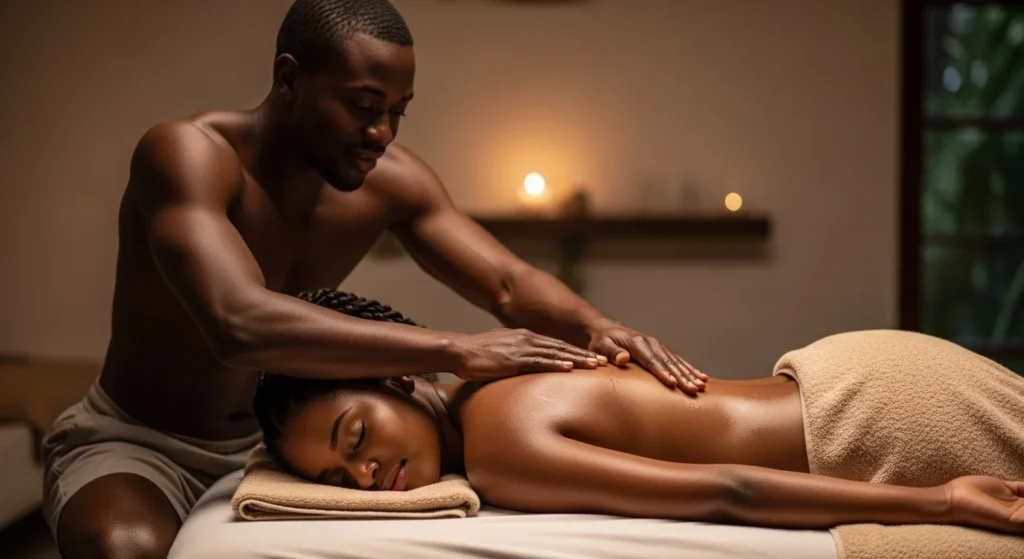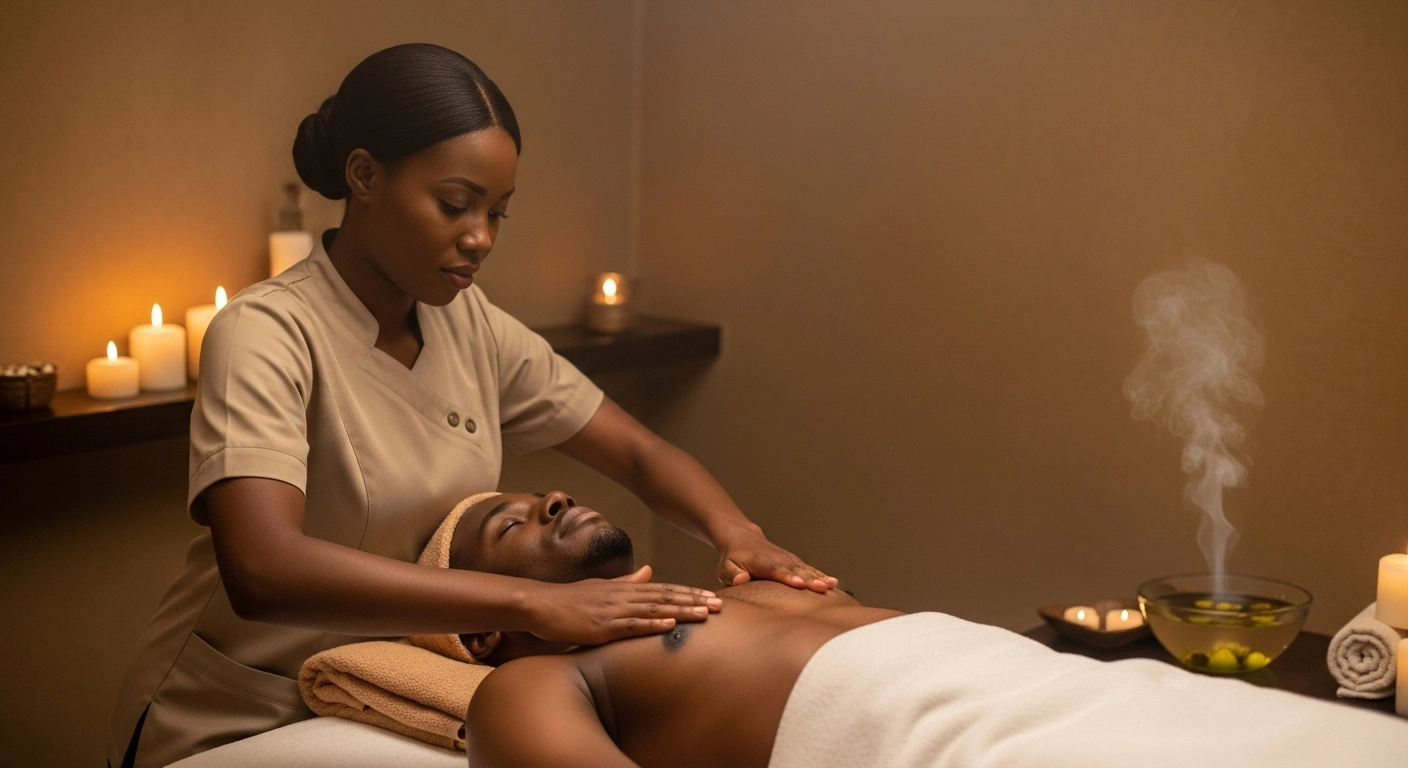Does your partner come home from work with that familiar tension in their shoulders and distraction in their eyes, making you feel like you’re living with a stranger? Maybe you’ve both become so burdened by daily stresses that even when you have time together, you’re physically present but mentally miles apart. This chronic stress doesn’t just affect individual wellbeing—it creates an invisible barrier between partners, making genuine connection feel like just another item on an overwhelming to-do list. You long to help your partner relax and reconnect, but your attempts often feel inadequate against the tidal wave of their stress.
What if your own two hands held the power to not just relieve your partner’s tension, but to transform your entire relationship dynamic? At Lebien etre, we’ve witnessed firsthand how intentional, loving touch can serve as a direct pathway from the frantic pace of modern life into a sanctuary of shared presence and connection. This isn’t about fancy techniques or perfect conditions—it’s about using simple, scientifically-backed massage principles to help your partner’s nervous system transition from survival mode into a state where intimacy, pleasure, and connection can naturally flourish. We’re here to guide you in becoming your partner’s personal sanctuary in a stressful world.
Why Stress Is the Silent Intimacy Killer
Chronic stress triggers our sympathetic nervous system (fight-or-flight response), making true connection virtually impossible. When your partner is stressed, their body is literally programmed to prioritize survival over intimacy.
This physiological state reduces blood flow to the brain’s social engagement center while increasing tension in major muscle groups. The stressed mind becomes preoccupied with threats and to-do lists rather than being present with a partner. Understanding this biological reality helps you approach your partner’s stress with compassion rather than frustration. Your touch can actually help shift their nervous system into the parasympathetic state where healing and connection occur.
The Science of Touch: More Than Just Feeling Good
Research confirms that loving touch does far more than just feel pleasant—it creates measurable physiological changes that counteract stress’s damaging effects.
Cortisol Reduction: Massage decreases cortisol (the stress hormone) by approximately 30% while increasing serotonin and dopamine (feel-good neurotransmitters).
Vagus Nerve Activation: Gentle, rhythmic touch stimulates the vagus nerve, which controls the parasympathetic nervous system responsible for relaxation and digestion.
Oxytocin Release: Loving touch boosts oxytocin, the “bonding hormone” that enhances feelings of trust and connection between partners.
Pain Gate Theory: Massage stimulates nerve fibers that can block pain signals, providing natural relief from tension headaches and muscle aches.
Creating the Transition Ritual: From Work Mode to Connect Mode
Help your partner shed the stress of the day with a simple transition ritual that signals to their nervous system that it’s safe to relax now.
The 60-Second Sanctuary: Begin with a full-body hug that lasts at least 60 seconds—this allows oxytocin to release and begins the relaxation process.
The Shoe Removal Ceremony: Have a comfortable chair where your partner can sit while you remove their shoes—a symbolic act of helping them shed the day’s burdens.
The Clothing Upgrade: Offer comfortable clothing to change into, physically replacing the “work uniform” with “home comfort wear.”
The Silent Welcome: Sometimes, the best initial greeting is simply quiet presence rather than questions about their day—let them decompress before conversing.
The De-Stress Massage Sequence: A 15-Minute Reset
This simple sequence focuses on areas where stress most commonly manifests. You don’t need prior experience—just willing hands and loving intention.
Minutes 1-3: Shoulder Melt
Stand behind your seated partner and place your hands firmly on their shoulders. Squeeze gently, then use your thumbs to make small circles along the trapezius muscles.
Minutes 4-6: Scalp Release
Gently massage the entire scalp using fingertips in circular motions. The scalp holds tremendous tension often overlooked in typical massages.
Minutes 7-9: Hand Relief
Massage each finger individually, then the palms. Our hands constantly work and rarely receive care despite containing numerous nerve endings.
Minutes 10-12: Foot grounding
Apply firm pressure to the soles of the feet, then massage each toe. This grounds energy and relieves tension from standing or sitting all day.
Minutes 13-15: Temple Soothing
Finish with gentle circles at the temples where stress often manifests as tension headaches. This signals complete relaxation.
The Art of Presence: Your Most Powerful Tool
Your quality of attention during massage matters more than any technique. When you’re fully present, your touch becomes a meditation that invites your partner into the present moment.
Breathe Together: Synchronize your breathing with your partner’s—this creates biochemical attunement that enhances connection.
Listen with Your Hands: Pay attention to subtle cues like muscle tension, temperature changes, and breathing patterns that guide your pressure and pace.
Release Expectations: Don’t approach massage with a goal of “fixing” your partner’s stress—simply offer touch as a gift without attachment to outcomes.
Practice Mindfulness: If your mind wanders, gently return your attention to the sensations in your hands and your partner’s responses.
Essential Elements for Stress-Relief Massage
A few simple additions can transform basic touch into a therapeutic experience that addresses stress on multiple levels.
-
Warmth: Use a heating pad on the back or neck before massaging to help muscles relax more easily. Our guide to warming techniques offers more ideas.
-
Pressure: Generally, firmer pressure works better for stress relief than light touch, which can sometimes tickle rather than relax.
-
Consistency: Rhythmic, predictable strokes are more calming than erratic or frequently changing techniques.
-
Duration: Even 10 minutes of focused massage provides significant stress relief, though 20-30 minutes is ideal for deeper relaxation.
Communicating During De-Stressing Massage
What you say (and don’t say) during stress-relief massage significantly impacts its effectiveness. These guidelines ensure your words support rather than hinder relaxation.
Ask Minimal Questions: Avoid complex questions that require mental effort. Stick to simple check-ins about pressure or comfort.
Use Soothing Tones: Speak more slowly and quietly than usual, matching the relaxed state you’re helping to create.
Offer Reassurance: Simple phrases like “I’ve got you” or “Just relax” can help your partner surrender to the experience.
Embrace Silence: Don’t feel compelled to fill silence—quiet can be deeply therapeutic for an overstimulated nervous system.
Beyond Physical Stress: Emotional Release Through Touch
Sometimes physical tension holds emotional stress. Creating a safe space allows massage to facilitate healthy emotional release when needed.
Normalize Tears: If your partner becomes emotional during massage, simply offer a tissue and continue touch without making it a big deal.
Avoid Analysis: Don’t try to analyze why emotions surface—simply provide supportive presence without interrogation.
Offer Reassurance: A simple “I’m here with you” acknowledges emotions without requiring your partner to explain or justify them.
Respect Boundaries: If emotions surface, you might ask “Would you like me to continue or would you prefer to pause?”
Building a Regular Practice: Consistency Over Perfection
Regular short sessions provide more cumulative stress relief than rare marathon massages. Integration beats intensity for managing chronic stress.
The 10-Minute Daily Practice: A brief daily shoulder or foot rub maintains connection and prevents stress from accumulating.
The Weekly Reset: A longer 30-minute session once a week helps release accumulated tension before it becomes overwhelming.
The Monthly Deep Reset: Occasionally, schedule a 60-minute full-body session for comprehensive stress relief and deeper connection.
Seasonal Awareness: Notice if stress patterns change with seasons—winter might need more warming techniques while summer might benefit from cooler approaches.
When Professional Help Is Needed
While partner massage is powerful, sometimes stress requires additional support. Recognizing these signs ensures your partner gets appropriate care.
Persistent Pain: If pain continues despite regular massage, encourage your partner to consult a healthcare provider.
Mental Health Concerns: If stress accompanies persistent sadness, anxiety, or loss of interest in activities, suggest speaking with a therapist.
Sleep Issues: Chronic insomnia alongside stress might indicate needs beyond what massage alone can address.
Relationship Patterns: If stress consistently disrupts your physical intimacy, consider couples counseling to address underlying patterns.
Expanding Your Skills Together
As massage becomes part of your relationship culture, you might naturally want to expand beyond basic stress relief into other forms of connection.
Explore Sensual Massage: Once stress is managed, sensual touch can deepen your intimate connection.
Learn Erotic Massage: For couples ready to explore, erotic massage can transform your sexual relationship.
Practice Conscious Touch: Incorporate consent practices that make all touch feel safer and more connected.
Try Quick Connections: Learn brief techniques for maintaining connection during busy periods.
Your Role as Healing Partner
Approaching massage as a healing practice rather than a technique changes both the giver and receiver experience profoundly.
Release Fixing Mentality: You’re not responsible for eliminating your partner’s stress—you’re offering support in managing it.
Practice Self-Care: Ensure you’re not depleting yourself to care for your partner—a stressed giver cannot help a stressed receiver.
Embrace Imperfection: Your loving intention matters more than perfect technique. Don’t let pursuit of excellence prevent you from starting.
Celebrate Small Shifts: Notice and appreciate subtle improvements—better sleep, less irritability, more laughter—that indicate your touch is helping.
The Ripple Effects of Regular Touch
When you make stress-relief massage a regular practice, benefits extend far beyond the massage itself into your entire relationship.
Improved Communication: Regular physical connection often leads to better emotional communication and easier conversations about desires.
Enhanced Intimacy: Reduced stress creates space for more spontaneous erotic touch and connection.
Shared Language: You develop a non-verbal language of touch that helps you rediscover each other beyond words.
Team Mentality: Working together against stress rather than against each other strengthens your partnership against life’s challenges.
Your Journey from Stress to Connection
At Lebien etre, we believe that helping your partner manage stress isn’t just an act of service—it’s an investment in your shared wellbeing and the foundation of a truly resilient relationship. Your touch becomes a powerful statement: “Your peace matters to me, and I’m here to help you find it.”
Remember that you don’t need to become a professional massage therapist to make a profound difference. You simply need to show up with willing hands, an open heart, and the commitment to create moments of sanctuary amid life’s chaos. Start tonight with a simple shoulder rub, and watch how this small act of love begins to transform not just your partner’s stress levels, but the very quality of your connection.







